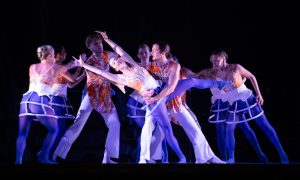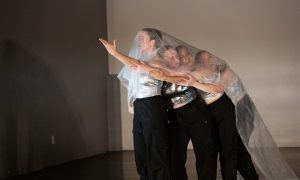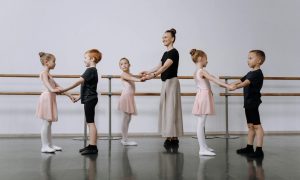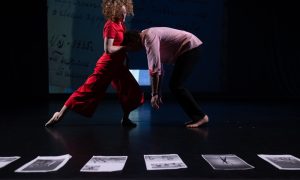The Boston Center for the Arts, Boston, MA.
May 11, 2025.
Dancers circled around an intimate stage space, facing the audience, and offered intricate gestures: accents clear yet quality soft. These gestures quickened and grew more complex, yet fluidity still prevailed. They wore pristine white shaped in edgy, and individualized, cuts.
These gestures came to connect ensemble members, a forearm transferring tenderness to another dancer – which that dancer extended to another dancer, catalyzing a wave of connection. The score – from Big Thief, as throughout the work – became more muscular and energetic.
Movement did in turn, extending both tight precision and easy indulgence. Relationships between ensemble members continued to build through that movement. Tenderness, tenacity, relationship, musicality: all these elements were clear right from this opening to Cassie Wang’s The Head Is Not The Star of the Body, and poignant throughout the entire work.
Wang and collaborators created and presented the work through a Boston Dancemakers Residency, via the Boston Center for the Arts. The program is an “incubator”, as Director of Dance and Interdisciplinary Arts Andrea Blesso described it: for fresh, innovative work from strong local dancemakers. Ilya Vidrin served as Dramaturg, and Dara Nicole Capley as Rehearsal Director.
The Head Is Not the Star of the Body held a mirror to big ideas such as nostalgia and interpersonal turbulence. Beautiful movement, abstraction leaving room for personal meaning, and a generally calming atmosphere made the view from that mirror both accessible and satisfying.
Nostalgia came through interweaving movement reflecting “air guitar”, playground fun (from line games such as “Red Rover” to clapping sequences a la “Miss Mary Mack” to parachute play from physical education class), and home video from Wang’s childhood (video editing by Wang and Kiki Temple).
A sense of delicate care translated through acts of witnessing, ensemble members watching two others dance a duet. Actions such back scratching, hair braiding, and soft hugs spoke to care. At times, some dancers even literally carried others: taking all of their weight so that, for a time, they didn’t have to hold it all themselves.
Yet, duets also reflected tension and conflict between two personas, angles and accent sharp. I pondered how the nostalgia and interpersonal tension on the stage’s moving canvas might be connected; memory can be sweetest when shared, but those who lived it don’t always see it the same.
Staging and movement vocabulary did much of the heavy lifting for conveying these ideas: calling upon both the highly pedestrian and notably virtuosic. Simple touches and weight sharing came along with complex floor-based vocabulary and precisely-timed acrobatics (such as handstands).
Physicality of action and of presence tangoed, giving and taking. At points, waltz, groove, and jazzy articulations expanded stylistic range – as well as brought more ease and lightness to the ether. All of that effectively contributed to the picture on that moving canvas, nothing prevailing over anything else.
The Big Thief tracks also set an apt aural atmosphere for these themes and qualities. The ensemble exhibited stellar musicality – attunement to each other’s timing and the score exacting, yet soft. It didn’t grasp, only landed in that comfortable “pocket” of timing.
Wang structured all of this into little dance vignettes, conveying varied relationships and energies. Part of me craved more ensemble sections in the first half of the work – which was mostly focused on duets between two central personas danced by Wang and Hannah Franz. The two brought affecting theatricality, highly keen kinetic attunement, and plain technical command: all captivating to watch.
Yet, I found myself craving a bit more structural balance in favor of more ensemble energy, their filling the stage with common movement made highly personal and honest – all of them gorgeous movers and theatrically entrancing. I felt more called to, more emotionally invested in, their story of community versus just two in relation.
Blesso had mentioned that this is “just the beginning” for the work. For further iterations, such structural evening-out of ensemble and duet sections is the main thing I would love to see re-molded, re-shaped.
I do understand an intention of wanting to center a certain relationship, with people coming in and out of our interactions – as they do in our lives. A framing of their story is very much legitimate, only less appealing to my heart and soul than the ensemble’s story.
I also point to potential editing down; I might challenge Wang, in a spirit of creative exploration and curiosity, to consider what sections might not be contributing more to the wonder and poignancy that she’s already established. Less can be more. That said, commendably, all sections and choices – in and of themselves – felt inventive rather than repetitive.
The pensive atmosphere, growing from all of that, softened a bit towards the end. An energetic crescendo had the ensemble clapping and singing while also dancing, facing the audience in vivacious, expansive ensemble movement.
Lights in the space turning off one by one, dancers sung together under a private fort made from a sheet (repurposed from serving for video projection) – recreating childhood sleepovers. The threads of nostalgia and interpersonal connection continued through to this soft, heartwarming end.
I hope it’s indeed not the last end for this work; I would love to see Wang refine and build upon it. Movement enthralling, score a perfect accompaniment, and themes deeply resonant, there is so much here that I hope more people can encounter.
The Head is Not The Star of The Body stands as a reminder of what artists can accomplish through supports like the Boston Dancemakers Residency, brought together with their raw grit and talent. Just as the title offers a timeless truth (granted, if one many in our culture aren’t conditioned to understand), it could truly be only the beginning. I joyfully anticipate more of the story told.
By Kathryn Boland of Dance Informa.















